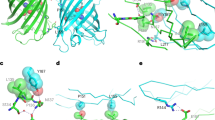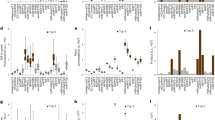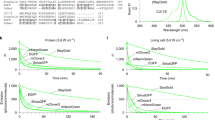Abstract
The high brightness and photostability of the green fluorescent protein StayGold make it a particularly attractive probe for long-term live-cell imaging; however, its dimeric nature precludes its application as a fluorescent tag for some proteins. Here, we report the development and crystal structures of a monomeric variant of StayGold, named mBaoJin, which preserves the beneficial properties of its precursor, while serving as a tag for structural proteins and membranes. Systematic benchmarking of mBaoJin against popular green fluorescent proteins and other recently introduced monomeric and pseudomonomeric derivatives of StayGold established mBaoJin as a bright and photostable fluorescent protein, exhibiting rapid maturation and high pH/chemical stability. mBaoJin was also demonstrated for super-resolution, long-term live-cell imaging and expansion microscopy. We further showed the applicability of mBaoJin for neuronal labeling in model organisms, including Caenorhabditis elegans and mice.
This is a preview of subscription content, access via your institution
Access options
Access Nature and 54 other Nature Portfolio journals
Get Nature+, our best-value online-access subscription
$29.99 / 30 days
cancel any time
Subscribe to this journal
Receive 12 print issues and online access
$259.00 per year
only $21.58 per issue
Buy this article
- Purchase on Springer Link
- Instant access to full article PDF
Prices may be subject to local taxes which are calculated during checkout





Similar content being viewed by others
Data availability
The PDB IDs are 8QBJ, 8Q79 and 8QDD for atomic structures of mBaoJin crystallized at pH 4.6, pH 6.5 and pH 8.5, respectively. The total size of the files acquired for this study exceeds the 20-GB limit of the FigShare repository, therefore only the most essential raw datasets, including source files for supplementary figures and raw unprocessed images, are available at figshare (https://doi.org/10.6084/m9.figshare.25001768). The remaining files are available from the corresponding author upon request. All plasmids used in this study are available from WeKwikGene (https://wekwikgene.wllsb.edu.cn/). Source data are provided with this paper.
Code availability
Custom code used in this study for BaLM imaging reconstruction is available at https://github.com/Perfus/mBaoJin.
References
Jacquemet, G., Carisey, A. F., Hamidi, H., Henriques, R. & Leterrier, C. The cell biologist’s guide to super-resolution microscopy. J. Cell Sci. 133, jcs240713 (2020).
Hirano, M. et al. A highly photostable and bright green fluorescent protein. Nat. Biotechnol. 40, 1132–1142 (2022).
Bustos, S. A. & Schleif, R. F. Functional domains of the AraC protein. Proc. Natl Acad. Sci. USA 90, 5638–5642 (1993).
Costantini, L. M., Fossati, M., Francolini, M. & Snapp, E. L. Assessing the tendency of fluorescent proteins to oligomerize under physiologic conditions. Traffic 13, 643–649 (2012).
Ando, R. et al. StayGold variants for molecular fusion and membrane-targeting applications. Nat. Methods https://doi.org/10.1038/s41592-023-02085-6. (2023).
Ivorra-Molla, E. et al. A monomeric StayGold fluorescent protein. Nat. Biotechnol. https://doi.org/10.1038/s41587-023-02018-w. (2023).
Cranfill, P. J. et al. Quantitative assessment of fluorescent proteins. Nat. Methods 13, 557–562 (2016).
Shaner, N. C. et al. Improving the photostability of bright monomeric orange and red fluorescent proteins. Nat. Methods 5, 545–551 (2008).
Balleza, E., Kim, J. M. & Cluzel, P. Systematic characterization of maturation time of fluorescent proteins in living cells. Nat. Methods 15, 47–51 (2017).
Campbell, B. C., Paez-Segala, M. G., Looger, L. L., Petsko, G. A. & Liu, C. F. Chemically stable fluorescent proteins for advanced microscopy. Nat. Methods https://doi.org/10.1038/s41592-022-01660-7 (2022).
Shinoda, H. et al. Acid-tolerant monomeric GFP from Olindias formosa. Cell Chem. Biol. 25, 330–338 (2018).
Shaner, N. C. et al. A bright monomeric green fluorescent protein derived from Branchiostoma lanceolatum. Nat. Methods 10, 407–409 (2013).
Zhao, W. et al. Sparse deconvolution improves the resolution of live-cell super-resolution fluorescence microscopy. Nat. Biotechnol. 40, 606–617 (2022).
Burnette, D. T., Sengupta, P., Dai, Y., Lippincott-Schwartz, J. & Kachar, B. Bleaching/blinking assisted localization microscopy for superresolution imaging using standard fluorescent molecules. Proc. Natl Acad. Sci. USA 108, 21081–21086 (2011).
Wachter, R. M. & Remington, S. J. Sensitivity of the yellow variant of green fluorescent protein to halides and nitrate. Curr. Biol. 9, 628–629 (1999).
Tutol, J. N., Kam, H. C. & Dodani, S. C. Identification of mNeonGreen as a pH-dependent, turn-on fluorescent protein sensor for chloride. ChemBioChem. 20, cbic.201900147 (2019).
Subach, O. M. et al. Slowly reducible genetically encoded green fluorescent indicator for in vivo and ex vivo visualization of hydrogen peroxide. Int. J. Mol. Sci. 20, 3138 (2019).
Subach, F. V. et al. Photoactivatable mCherry for high-resolution two-color fluorescence microscopy. Nat. Methods 6, 153–159 (2009).
Subach, O. M. et al. LSSmScarlet, dCyRFP2s, dCyOFP2s and CRISPRed2s, genetically encoded red fluorescent proteins with a large Stokesshift. Int. J. Mol. Sci. 22, 12887 (2021).
Zhang, H. et al. Quantitative assessment of near-infrared fluorescent proteins. Nat. Methods 20, 1605–1616 (2023).
Schindelin, J. et al. Fiji: an open-source platform for biological-image analysis. Nat. Methods 9, 676–682 (2012).
Descloux, A., Grußmayer, K. S. & Radenovic, A. Parameter-free image resolution estimation based on decorrelation analysis. Nat. Methods 16, 918–924 (2019).
Huang, X. et al. Fast, long-term, super-resolution imaging with Hessian structured illumination microscopy. Nat. Biotechnol. 36, 451–459 (2018).
Green, R. A. et al. Expression and imaging of fluorescent proteins in the C. elegans gonad and early embryo. Methods Cell. Biol. 85, 179–218 (2008).
Piatkevich, K. D., Sun, C., Sun, X. & Xiao, K. Methods for physical expansion of samples and uses thereof. Patent 1–72 (2022).
Kabsch, W. XDS. Acta Crystallogr. D Biol. Crystallogr. 66, 125–132 (2010).
Vagin, A. & Teplyakov, A. MOLREP: an automated program for molecular replacement. J. Appl. Crystallogr. 30, 1022–1025 (1997).
Collaborative Computational Project, N. 4 & IUCr. The CCP4 suite: programs for protein crystallography. Acta Crystallogr. D Biol. Crystallogr. 50, 760–763 (1994).
Emsley, P. & Cowtan, K. COOT: model-building tools for molecular graphics. Acta Crystallogr. D Biol. Crystallogr. 60, 2126–2132 (2004).
Berman, H. M. et al. The Protein Data Bank. Nucleic Acids Res. 28, 235–242 (2000).
Acknowledgements
We are grateful to A. N. Asanova and A. N. Romantsova for their help with mammalian plasmids cloning. We thank G. G. Lambert and N. Shaner for providing the mChilada gene. We thank Guangzhou CSR Biotech Co. for assistance with live-cell imaging and image analysis using HIS-SIM. The work was carried out within the state assignment of NRC Kurchatov Institute (development of mBaoJin and characterization of mBaoJin in vitro) and thematic plan of NRC Kurchatov Institute (crystallization and X-ray analysis); by the Ministry of Science and Higher Education of the Russian Federation for the development of the Kurchatov Center for Genome Research 075-15-2019-1659 (protein purification); by start-up funding from the Foundation of Westlake University, Westlake Laboratory of Life Sciences and Biomedicine, National Natural Science Foundation of China grant 32171093 and ‘Pioneer’ and ‘Leading Goose’ R&D Program of Zhejiang 2024SSYS0031 to K.D.P. (characterization of mBaoJin in mammalian cells and super-resolution imaging). Assessment of the mBaoJin reporter in BaLM super-resolution microscopy was funded by the Russian Science Federation, project no. 22-14-00400 (https://rscf.ru/project/22-14-00400/). The work was also supported by the Resource Centers department of the National Research Center Kurchatov Institute (imaging of bacteria). The authors acknowledge the BL19U1 beamline of the National Facility for Protein Science Shanghai at Shanghai Synchrotron.
Author information
Authors and Affiliations
Contributions
G.D.L., O.M.S. and F.V.S. developed mBaoJin and characterized it in vitro. F.V.S. and T.P.K. obtained mutants of mBaoJin and characterized their properties in vitro. A.V.V. and H.Z. purified mBaoJin. H.Z., K.D.P. and F.V.S. characterized mBaoJin in mammalian cells and performed live-cell imaging. M.D. measured QY of proteins. S.P. and H.Z. performed the OSER assay. H.Z. characterized proteins in vivo. H.Z. and W.Z. performed ExM. L.C., X.Y., H.Z. and K.D.P. performed SIM. M.M.P., A.S.G. and A.S.M. performed BaLM microscopy. A.G., V.B. and W.Q. performed X-ray data collection. A.Yu.N. performed crystallization. V.R.S. performed crystallization, structure solution, refinement and analysis. K.D.P., F.V.S, H.Z., M.M.P., V.R.S. and A.S.M. wrote the manuscript. K.D.P. and F.V.S. supervised all aspects of the project. All authors reviewed the manuscript.
Corresponding authors
Ethics declarations
Competing interests
K.D.P. is the co-founder of a company that pursues commercial applications of ExM and is listed as an inventor on several patent applications concerning the development of new ExM methods. The other authors declare no competing interests.
Peer review
Peer review information
Nature Methods thanks Dominique Bourgeois, Benjamin Campbell and Yi Yang for their contribution to the peer review of this work. Peer reviewer reports are available. Primary Handling Editor: Rita Strack, in collaboration with the Nature Methods team.
Additional information
Publisher’s note Springer Nature remains neutral with regard to jurisdictional claims in published maps and institutional affiliations.
Supplementary information
Supplementary Information
Supplementary Tables 1–11 and Supplementary Figs. 1–21
Supplementary Video 1
Three-dimensional view of expanded HeLa cell coexpressing H2B-mTurquoise2 and Mito (COX8Ax2)-mBaoJin acquired in the CFP and GFP channels using a Nikon spinning disk microscope (linear expansion factor 3.4×).
Supplementary Video 2
Long-term super-resolution imaging of tubulin dynamics in HeLa cells using CSU-W1 SoRa imaging setup (×100 NA 1.41, sampling rate 0.2 Hz, total duration 60 min).
Supplementary Video 3
Long-term super-resolution imaging of actin dynamics in HeLa cells using CSU-W1 SoRa imaging setup (×100 NA 1.41, sampling rate 0.2 Hz, total duration 30 min).
Supplementary Video 4
Long-term super-resolution imaging of EB3 dynamics in HeLa cells using CSU-W1 SoRa imaging setup (×100 NA 1.41, sampling rate 1 Hz, total duration 2 :30 min).
Supplementary Video 5
Long-term super-resolution imaging of actin dynamics with mBaoJin in HeLa cells using HIS-SIM imaging setup (×100 NA 1.41, sampling rate 0.1 Hz, total duration 15 min).
Supplementary Video 6
Long-term super-resolution imaging of actin dynamics with mNeonGreen in HeLa cells using HIS-SIM imaging setup (×100 NA 1.41, sampling rate 0.1 Hz, total duration 15 min).
Supplementary Video 7
Video showing 500 frames of vimentin-mBaoJin in live HeLa cells. Plays at 20 f.p.s. (acquisition speed 20 f.p.s.).
Supplementary Video 8
Video showing 1,000 frames of vimentin-mBaoJin in live HeLa cells. Plays at 100 f.p.s. (acquisition speed 100 f.p.s.).
Supplementary Video 9
Video showing 1,000 frames of vimentin-mBaoJin in live HeLa cells. Plays at 200 f.p.s. (acquisition speed 200 f.p.s.).
Supplementary Video 10
Video showing 500 frames of vimentin-mNeonGreen in live HeLa cells. Plays at 20 f.p.s. (acquisition speed 20 f.p.s.).
Supplementary Video 11
Video showing 1,000 frames of vimentin-mNeonGreen in live HeLa cells. Plays at 100 f.p.s. (acquisition speed 100 f.p.s.).
Supplementary Video 12
Video showing 1,000 frames of vimentin-mNeonGreen in live HeLa cells. Plays at 200 f.p.s. (acquisition speed 200 f.p.s.).
Supplementary Video 13
The 21 reconstructed frames of vimentin-mBaoJin in live HeLa cell. Acquisition speed 200 f.p.s. Each frame was reconstructed from 10,000 raw frames (50 s of acquisition). Time shift between reconstructed frames was 5 s. Video plays at three reconstructed f.p.s. Scale bar, 500 nm.
Supplementary Video 14
The 16 reconstructed frames of vimentin-mNeonGreen in live HeLa cell. Acquisition speed 200 f.p.s. Each frame was reconstructed from 10,000 raw frames (50 s of acquisition). Time shift between reconstructed frames was 5 s. Video plays at three reconstructed f.p.s. Scale bar, 500 nm.
Source data
Source Data Fig. 1
Source data.
Source Data Fig. 2
Source data.
Source Data Fig. 3
Source data.
Source Data Fig. 4
Source data.
Source Data Fig. 5
Source data.
Rights and permissions
Springer Nature or its licensor (e.g. a society or other partner) holds exclusive rights to this article under a publishing agreement with the author(s) or other rightsholder(s); author self-archiving of the accepted manuscript version of this article is solely governed by the terms of such publishing agreement and applicable law.
About this article
Cite this article
Zhang, H., Lesnov, G.D., Subach, O.M. et al. Bright and stable monomeric green fluorescent protein derived from StayGold. Nat Methods 21, 657–665 (2024). https://doi.org/10.1038/s41592-024-02203-y
Received:
Accepted:
Published:
Issue Date:
DOI: https://doi.org/10.1038/s41592-024-02203-y
This article is cited by
-
Breaking up the StayGold dimer yields three photostable monomers
Nature Methods (2024)



